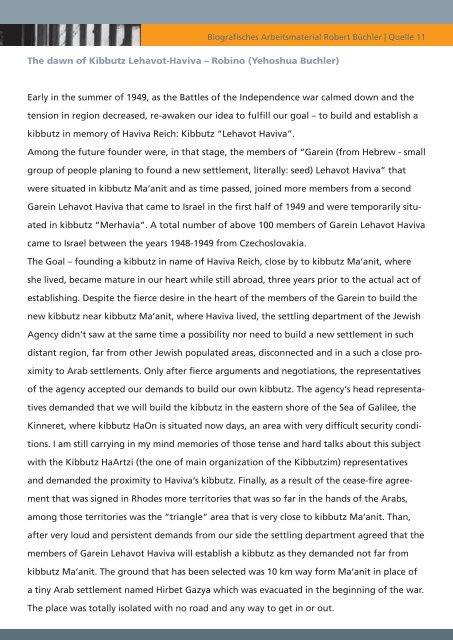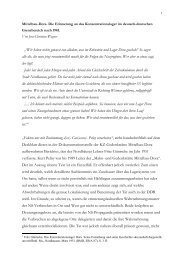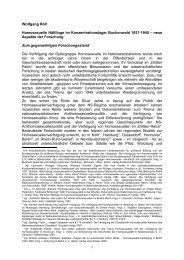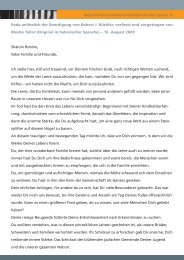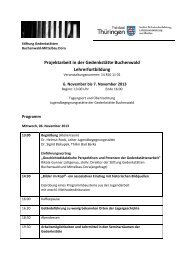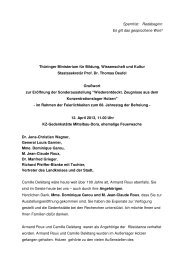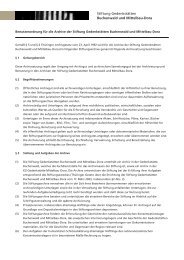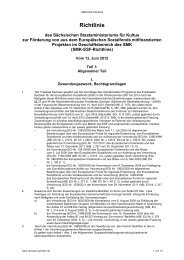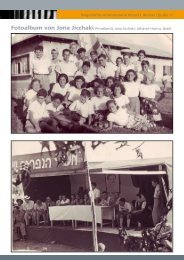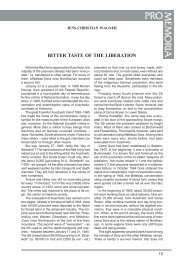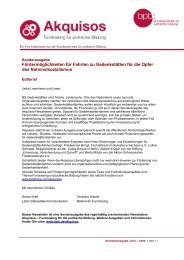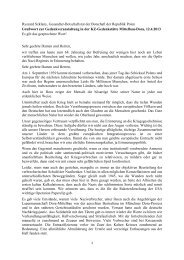The dawn of Kibbutz Lehavot-Haviva â Robino (Yehoshua Buchler ...
The dawn of Kibbutz Lehavot-Haviva â Robino (Yehoshua Buchler ...
The dawn of Kibbutz Lehavot-Haviva â Robino (Yehoshua Buchler ...
You also want an ePaper? Increase the reach of your titles
YUMPU automatically turns print PDFs into web optimized ePapers that Google loves.
Biografisches Arbeitsmaterial Robert Büchler | Quelle 11<br />
<strong>The</strong> <strong>dawn</strong> <strong>of</strong> <strong>Kibbutz</strong> <strong>Lehavot</strong>-<strong>Haviva</strong> – <strong>Robino</strong> (<strong>Yehoshua</strong> <strong>Buchler</strong>)<br />
Early in the summer <strong>of</strong> 1949, as the Battles <strong>of</strong> the Independence war calmed down and the<br />
tension in region decreased, re-awaken our idea to fulfill our goal – to build and establish a<br />
kibbutz in memory <strong>of</strong> <strong>Haviva</strong> Reich: <strong>Kibbutz</strong> “<strong>Lehavot</strong> <strong>Haviva</strong>”.<br />
Among the future founder were, in that stage, the members <strong>of</strong> “Garein (from Hebrew - small<br />
group <strong>of</strong> people planing to found a new settlement, literally: seed) <strong>Lehavot</strong> <strong>Haviva</strong>” that<br />
were situated in kibbutz Ma‘anit and as time passed, joined more members from a second<br />
Garein <strong>Lehavot</strong> <strong>Haviva</strong> that came to Israel in the first half <strong>of</strong> 1949 and were temporarily situated<br />
in kibbutz “Merhavia”. A total number <strong>of</strong> above 100 members <strong>of</strong> Garein <strong>Lehavot</strong> <strong>Haviva</strong><br />
came to Israel between the years 1948-1949 from Czechoslovakia.<br />
<strong>The</strong> Goal – founding a kibbutz in name <strong>of</strong> <strong>Haviva</strong> Reich, close by to kibbutz Ma‘anit, where<br />
she lived, became mature in our heart while still abroad, three years prior to the actual act <strong>of</strong><br />
establishing. Despite the fierce desire in the heart <strong>of</strong> the members <strong>of</strong> the Garein to build the<br />
new kibbutz near kibbutz Ma‘anit, where <strong>Haviva</strong> lived, the settling department <strong>of</strong> the Jewish<br />
Agency didn‘t saw at the same time a possibility nor need to build a new settlement in such<br />
distant region, far from other Jewish populated areas, disconnected and in a such a close proximity<br />
to Arab settlements. Only after fierce arguments and negotiations, the representatives<br />
<strong>of</strong> the agency accepted our demands to build our own kibbutz. <strong>The</strong> agency‘s head representatives<br />
demanded that we will build the kibbutz in the eastern shore <strong>of</strong> the Sea <strong>of</strong> Galilee, the<br />
Kinneret, where kibbutz HaOn is situated now days, an area with very difficult security conditions.<br />
I am still carrying in my mind memories <strong>of</strong> those tense and hard talks about this subject<br />
with the <strong>Kibbutz</strong> HaArtzi (the one <strong>of</strong> main organization <strong>of</strong> the <strong>Kibbutz</strong>im) representatives<br />
and demanded the proximity to <strong>Haviva</strong>‘s kibbutz. Finally, as a result <strong>of</strong> the cease-fire agreement<br />
that was signed in Rhodes more territories that was so far in the hands <strong>of</strong> the Arabs,<br />
among those territories was the “triangle” area that is very close to kibbutz Ma‘anit. Than,<br />
after very loud and persistent demands from our side the settling department agreed that the<br />
members <strong>of</strong> Garein <strong>Lehavot</strong> <strong>Haviva</strong> will establish a kibbutz as they demanded not far from<br />
kibbutz Ma‘anit. <strong>The</strong> ground that has been selected was 10 km way form Ma‘anit in place <strong>of</strong><br />
a tiny Arab settlement named Hirbet Gazya which was evacuated in the beginning <strong>of</strong> the war.<br />
<strong>The</strong> place was totally isolated with no road and any way to get in or out.
Biografisches Arbeitsmaterial Robert Büchler | Quelle 11<br />
From the moment we found out about the approval big plans and argument were held<br />
about the day <strong>of</strong> settling. From the people in charge we demanded to show us the actual<br />
place but they rejected the demand, I guess that because <strong>of</strong> lack <strong>of</strong> coordination with the<br />
Ministry <strong>of</strong> Defense.<br />
Despite the severe ban, at the end <strong>of</strong> august 1949, three members decided to go secretly<br />
throw the army posts behind Ein-Shemer Army base (Sha‘ar Manashe <strong>of</strong> today) and try to<br />
discover the place intended for settling. Shmuel Shtark, Tuvia Be‘eri and myself went out <strong>of</strong><br />
kibbutz Ma‘anit early in the morning, and began marching, before <strong>dawn</strong>, toward the intended<br />
location, marked by the leaders <strong>of</strong> the settling movement on the map.<br />
After few hours <strong>of</strong> marching in high thorny bushes we suddenly discovered near a dry seasonal<br />
stream, between the trees, a few abandon structures covered with vegetation. In the<br />
western part <strong>of</strong> the small settlement we found a natural water well with a big pump. As far<br />
as we know, the original habitants <strong>of</strong> Hirbet Gazya, few tens in numbers, left their village in<br />
the spring <strong>of</strong> 1948 and since than we were the first Israelis that managed to get there. <strong>The</strong><br />
place seemed distant and quite relatively to the tense atmosphere at that time in Israel. We<br />
were impressed <strong>of</strong> the fresh air and the vast agriculture land. We were convinced that in this<br />
place we can build a magnificent kibbutz. <strong>The</strong> intended ground were between two seasonal<br />
streams and near the old Kakun railway station.We wondered around the field for a few<br />
hours and just before the evening we where heading back to Ma‘anit.<br />
At first we kept the story <strong>of</strong> the illegal-expedition to Hirbet Gazya as a secret but with time I<br />
couldn‘t hold the secret and told it to a few close friends and described every thing we saw.<br />
<strong>The</strong> story spread a lot <strong>of</strong> curiosity among my fellow Garein members, few others tried to get<br />
thereby themselves but with no success, the Israeli army totally closed any passage to the<br />
area. It is possible to presume that until the 19th October no one else has visited the area.<br />
Earlier than that the Jewish Agency announced that the day <strong>of</strong> settling is set to the 20th October<br />
1949.<br />
All the Garein members were excited and involved with preparation. As the settling day came<br />
closer the settling department gathered materials in the close by settlements: Parts <strong>of</strong> walls to<br />
the wooden shakes, wooden boards and sacks <strong>of</strong> cement, prepared tractors and trucks.<br />
On the day, Thursday the 20th October 1949, few days after the holiday <strong>of</strong> Sukkot, a few<br />
bulldozers came out <strong>of</strong> the Ein-Shemer army base and began clearing out a path, behind the
Biografisches Arbeitsmaterial Robert Büchler | Quelle 11<br />
bulldozers slowly advanced a line <strong>of</strong> tractors and trucks loaded with building materials, wooden<br />
boards, module parts <strong>of</strong> shakes, different tools and an electric generator.<br />
Sited on the vehicles were the members <strong>of</strong> Garein <strong>Lehavot</strong> <strong>Haviva</strong> that helped forming the<br />
newly built path.<br />
After the completion <strong>of</strong> the path, residents <strong>of</strong> near by kibbutzim came to the intended<br />
ground and helped preparing the land for construction and started building shakes and at<br />
the same time came the other members <strong>of</strong> the Garein <strong>Lehavot</strong> <strong>Haviva</strong> from kibbutz Merhavia<br />
and joined the works and the construction <strong>of</strong> the new kibbutz. It was known that the ceremony<br />
for the birth <strong>of</strong> the new kibbutz will be held at the same day‘s afternoon and among<br />
the participants are people from the Jewish agency, representatives <strong>of</strong> the <strong>Kibbutz</strong> HaArtzi,<br />
representatives <strong>of</strong> other kibbutzim and parents and relatives <strong>of</strong> members <strong>of</strong> the kibbutz.<br />
Among the speakers were the head <strong>of</strong> the settling department and the head <strong>of</strong> the local<br />
council – Haim Kafri that was a close friend <strong>of</strong> <strong>Haviva</strong> Rich and many others.<br />
<strong>The</strong> ceremony was impressive but only handful <strong>of</strong> <strong>Lehavot</strong> <strong>Haviva</strong> members participated,<br />
most <strong>of</strong> us were still working in constructing structures meant for lodging and storage. As<br />
the darkness came closer 4 newly built shakes were standing (although with no ro<strong>of</strong> and<br />
floor), temporary kitchen along side a ruined structure, a few tents (as one big tent was used<br />
as a dinning room) and also along the night some members kept on working as an oil-lamps<br />
providing illumination.<br />
At the end <strong>of</strong> October 1949 <strong>Lehavot</strong> <strong>Haviva</strong> was a tiny and exposed settlement without<br />
electricity and water, no shade and no roads and ways <strong>of</strong> accessing it. <strong>The</strong> contact with<br />
the near by settlements was held via the fields toward kibbutz “Gan Shmuel” and kibbutz<br />
Ma‘anit and via the faulty road that was built on the settling day. A fundamental change to<br />
the road happened in the beginning <strong>of</strong> the next year‘s winter.<br />
<strong>The</strong> winter <strong>of</strong> 1950 brought with it great quantities <strong>of</strong> rain and an unusual snow phenomenon.<br />
<strong>The</strong> seasonal streams around the kibbutz were filled with water and flooded the whole area.<br />
<strong>The</strong> kibbutz and his members were totally cut <strong>of</strong>f and isolated for some time. Our chains<br />
tractor sank deep in the mud and got stuck. <strong>The</strong> members <strong>of</strong> the kibbutz had to march to the<br />
railway tracks and from there by foot to Hadera and other places to get supply.<br />
<strong>The</strong> weather caused severe damage to the shakes and water penetrated to the temporary<br />
dining room. <strong>The</strong> rainy and hard winter didn‘t allow organized continuation <strong>of</strong> the construc-
Biografisches Arbeitsmaterial Robert Büchler | Quelle 11<br />
tion. <strong>The</strong> members <strong>of</strong> the kibbutz were buzzy fixing and sealing up the cracks which the rain<br />
penetrated.<br />
Despite all the trouble, the moral among the kibbutz members was high. Almost every night<br />
there were dancing until late at night, to a music provided by a manual gramophone as we<br />
did not had electricity yet. When the rain ceased we made a road to the nearest Arab village,<br />
Jalame west to the kibbutz and from Jalame it was possible to get to the main road that<br />
went through the Arab villages <strong>of</strong> Baka el-Garbia and Jat and from there to Ma‘anit and<br />
Hadera.<br />
At the beginning <strong>of</strong> the spring <strong>of</strong> 1950 we found out that we are ordered to re-locate our<br />
settlement and move to the tiny village Jalame that its inhabitants were expelled by the<br />
Israeli army. <strong>The</strong> decision was made after discussion between the Ministry <strong>of</strong> Defense and the<br />
Jewish Agency about ensuring the security <strong>of</strong> the region.<br />
<strong>The</strong> members <strong>of</strong> the kibbutz were disappointed, we need to dissemble everything, we have<br />
to built and to move it to the village Jalame that turned out, with no ceremonies and celebrations<br />
to the new <strong>Lehavot</strong> <strong>Haviva</strong> at the end <strong>of</strong> the spring 1950. In this migration and<br />
together with the members <strong>of</strong> our Garein from Merhavia there were 100 members <strong>of</strong> the<br />
kibbutz. At the beginning almost all <strong>of</strong> us lived in the neglected and primitive structures left<br />
by the Arabs. At the same time we went through a difficult experience: Most <strong>of</strong> the members<br />
<strong>of</strong> our kibbutz had fallen ill with typhus and were hospitalized. It has turned out that the disease<br />
spread mostly among the members who lived in the old and filthy Arab buildings. <strong>The</strong><br />
experience was a blow to the kibbutz members and delayed its development.<br />
As was described here, kibbutz <strong>Lehavot</strong> <strong>Haviva</strong> was established twice. Today it is located in<br />
the place, where was the village Jalame and instead <strong>of</strong> the village Gazya was founded a few<br />
years later the moshav Sade-Yitzhak.<br />
aus: 60 Jahre Kibbuz <strong>Lehavot</strong> <strong>Haviva</strong> (Original in hebräischer Sprache, Übersetzung ins Englische<br />
von Omer Hannash), editiert von Amira Hagani, <strong>Lehavot</strong> <strong>Haviva</strong> 2009, S. 21-23.


